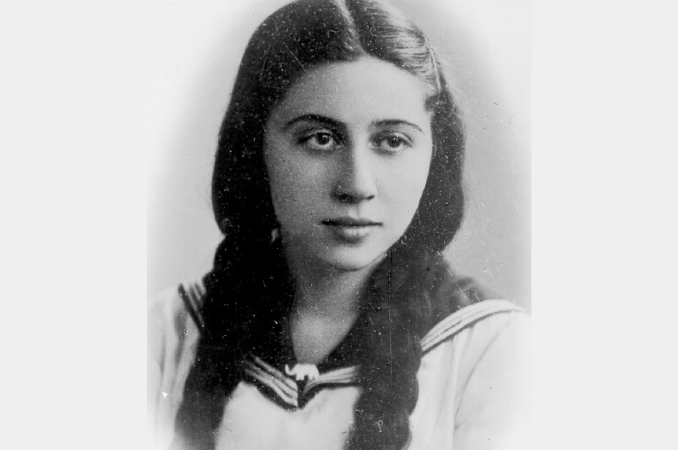Niuta (Rywka) Tajtelbaum (1917–1943)
Underground activist and heroine of the Warsaw Ghetto Uprising, deputy commander of the combat division of the People’s Guard (Gwardia Ludowa).
A slender girl, dressed as a peasant woman, knocks on the door of an apartment on Chmielna Street in Warsaw. Her blue eyes and blonde braids arouse no suspicion. She says she is selling milk. When the maid opens the door, several fighters hidden behind her suddenly rush inside. Shots are fired. Two Gestapo agents are killed on the spot. The third, wounded, is taken to the hospital.
Soon the same blonde woman volunteers to “finish” the task. At the hospital on Aleje Jerozolimskie, she poses as the wounded man’s fiancée. She enters the ward, pretends to cry, and speaks to the unconscious agent in German. The nurse attending suspects nothing. As she leaves, the girl shoots the Gestapo man and escapes undetected.
Although this is only one version of the event, in the recollections of Niuta (Rywka) Tajtelbaum’s friends, she was already remembered then as an “extremely daring and heroic girl.”
She was born on October 31, 1917, in Łódź, into a religious Jewish family. Her mother was Rajzlia, née Hamburger, and her father, Icchak (Icek) Mendel (Majer) Tajtelbaum, was a wealthy factory owner descended from the Hasidic community of Sochaczew. The large family (Niuta had ten sisters) lived in an elegant tenement house on Piotrkowska Street. She began her education at the Beyt Yaakov school for religious Jewish girls and later attended the Josef Aba Humanities Girls’ Gymnasium.
Even as a young girl, she showed solidarity with the striking workers employed at her father’s factory. She was drawn to left-wing ideas, which caused unrest within the family. She felt a strong bond with her loved ones, but she could not ignore poverty and injustice. As her friend Jerzy Duracz, alias “Felek,” recalled:
“Having met starving workers, she felt a burning shame that she could live in comfort. From then on, she would take bread from home, give away everything she had… She even found a quiet accomplice at that time in her mother.”
She became involved in the activities of the Socialist Union of School Youth, and later in the Communist Union of Polish Youth. She was particularly active in the illegal “Spartakus” organization, which operated among high school students. She served as an instructor for children in the “Pioneer” organization. Despite being expelled from school for underground activity, she passed her final exams (matura) in 1936.
She began her studies in philosophy and history at the University of Warsaw. Together with Kazia Kagan, Hanka Bela Krakowska, and Lunią Rozental, she actively opposed the segregation of Jewish students (the so-called ghetto benches) and manifestations of antisemitism among nationalist students. The outbreak of war in September 1939 brutally interrupted her education. Together with Kagan, Krakowska, and Rozental, she went to Lviv, where she continued her involvement in left-wing circles. After the Germans occupied the city and the Jewish population was massacred in the autumn of 1941, the friends returned to Warsaw.
In the Warsaw Ghetto, she lived with her sister Ina, her husband, and their children on Dzielna Street. At that time, the Union of Liberation Struggle (ZWW) was formed — a communist organization that Niuta joined along with her friends. Initially, they focused on education and aid for the poorest. Over time, they turned to planning sabotage and diversionary actions, as the communist underground leadership had decided, in the words of Kazia Kagan, that “in the present period (the occupation), individual terror is both permitted and necessary.”
In January 1942, Niuta became a member of the newly established Polish Workers’ Party (PPR), which began forming small combat groups. Niuta trained her seven-member group of female comrades, teaching them, among other things, how to plant mines and make explosives.
In March 1942, the PPR committee in the ghetto proposed forming a united bloc of left-wing organizations, later called the Anti-Fascist Bloc. The bloc included communists and left-wing Zionist movements (such as Ha-Shomer Ha-Tzair). Niuta became a liaison for the bloc, crossing to the “Aryan side” to establish contact with resistance centers in other ghettos across the country.
In August 1942, during the Great Deportation from the ghetto, she left with the first PPR group to join the partisans but returned to Warsaw after several weeks to continue her work as a liaison for both the Anti-Fascist Bloc and the PPR, under the pseudonym Wanda Witwicka. She transported weapons, underground press, and information into the ghetto, and helped organize housing for fugitives on the Aryan side.
Kazia Kagan recalled:
“Niuta showed maximum initiative in solving difficult problems. She was everywhere — she would seemingly conjure up apartments and money out of thin air.”
In November 1942, she was accepted into the “Special Group” (Specgrupa) of the People’s Guard — a PPR combat unit assigned the most dangerous missions. She participated in all major operations carried out by this unit in Warsaw. She spoke fluent German, which — combined with her talent for disguise — allowed her to infiltrate German establishments.
The group’s first major operation was an attack on the Municipal Savings Bank. They captured one million zlotys that the Germans had earlier seized from Warsaw residents as collective punishment for attacks on German venues (“Cafe Club,” “Mitropa”) carried out by the People’s Guard. Niuta’s task was to cut off the telephones and distract the cashier — a mission she completed successfully.
The apartment she rented at 19 Poznańska Street became the meeting point of the Special Group, which by late December was ready for further operations, equipped with pistols and grenades.
Together with Jerzy Duracz, she formed a close combat duo. They often went on missions as a pair:
“I asked to go on operations with her. We formed a fighting pair. You could rely on Niuta one hundred percent. You knew she would never lose her nerve, never fail, never forget her comrade or abandon him in need. She had the gift of winning people over, always surrounded by the best of them… She herself was honest, pure in her intentions, never tainted by falsehood,” he later recalled.
One such action was the bombing of the Kammerlichtspiele cinema on Marszałkowska Street (January 1943), carried out in retaliation for mass roundups of Warsaw residents. Other missions in which Niuta and Jerzy took part included attacks on German venues, assassinations of Gestapo agents, informers, and blackmailers (szmalcownicy). Most were successful — such as the previously mentioned attack on three Gestapo officers at the apartment on Chmielna Street.
Shortly before the Ghetto Uprising, Jerzy became involved in helping Niuta’s family. Thanks to his assistance, her sister Ina and her two children were smuggled out of the ghetto.
When the uprising broke out on April 19, 1943, Niuta attended a meeting led by the People’s Guard chief of staff, Franciszek Jóźwiak, alias “Witold.” They discussed organizing support actions for the fighting ghetto. The Special Group received a request from the Jewish Combat Organization (ŻOB) to eliminate a German machine gun position that was firing on insurgents gathered in a brush-making workshop area beyond the ghetto wall.
A five-person Special Group of the People’s Guard, including Niuta, armed with pistols and grenades, managed to approach the German gun emplacement closely (the guardsmen took advantage of the crowd of Warsaw residents who had gathered to watch the fighting as though it were a spectacle). They opened fire on the Germans. Accounts of the action differ in detail, but it is certain that the group succeeded in damaging (or destroying) the anti-aircraft gun, killing two Germans, and wounding several Polish Blue Police officers supporting them. Panic broke out among the spectators — the crowd fled and trampled over one another, which allowed the fighters to withdraw without losses.
The second planned operation was to set fire to SS warehouses in Bródno. As Niuta put it, “let the glow of fires over Bródno remind them of the glow over the ghetto,” as Jerzy Duracz later quoted her. Although that operation failed, others succeeded — railway tracks were blown up, and they helped the Jews to escape from transports.
“That small, slender girl with blue eyes and beautiful blonde hair drew attention through all these actions and earned from the Gestapo the nickname ‘Die Kleine Blonde,’”
recalled Anna Duracz.
When the Gestapo began searching for her, she changed her appearance, dyed her hair, and wore various disguises. In May 1943, she received orders to leave Warsaw for her own safety. She went not far — only to Zielonka (about 50 km from Warsaw) — but she often returned to the city. When visiting friends, she tried to obey the order not to go near her apartment.
In her comrades’ recollections, Niuta is described as someone with a sense of humor, “who loved music, flowers, theater, and poetry,” but over time she was increasingly affected by the tragedy of the ghetto:
“She sang less and less, smiled less and less, and the eyes that had once sparkled with laughter became deep and tragic,” wrote Jerzy.
On July 19, 1943, she was arrested in the doorway of the building where her apartment was located — 19 Poznańska Street. Reportedly, she was in Warsaw, despite the danger, to find a hiding place for her sister. The Gestapo overpowered her before she could reach for her weapon. She was taken to Gestapo Headquarters at Aleja Szucha street, where she was tortured for many weeks. Her friends were ordered to leave the apartment. Niuta did not reveal any names, pseudonyms, or addresses — she betrayed no one. She was executed by the Gestapo in September 1943.
Hania Mączkowska (Anna Duracz) recalled:
“She was one of the noblest and strongest, most unyielding figures — one who fought most consciously ‘for our freedom and yours.’”
Posthumously, on April 19, 1945, she was awarded the Order of the Cross of Grunwald, 3rd Class.
Bibliography
Dołowy, P., Niuta Tajtelbaum. Wanda with Braids, in: A Matter of Character. Female Fighters from the Warsaw Ghetto, eds. S. Chutnik, M. Sznajderman.
Mark, B., Walka i zagłada warszawskiego getta, Warsaw, 1959 ((The Struggle and Annihilation of the Warsaw Ghetto).
Mark, B., The Uprising in the Warsaw Ghetto, Warsaw, 1963.
Strzembosz T., Akcje zbrojne podziemnej Warszawy 1939–1944, Warszawa 1978 (Armed Actions of Underground Warsaw 1939–1944)
Testimony of Anna Duracz, Yad Vashem Archives, 1971, ref. no. O.3/3586.
Testimony of Jerzy Duracz, Jewish Historical Institute Archives (AŻIH), ref. no. 301/5017.
Testimony of Jerzy Duracz, Yad Vashem Archives, 1972, ref. no. O.3/3587.
Testimony of Kazimiera Kagan, Jewish Historical Institute Archives (AŻIH), ref. no. 301/2295.


